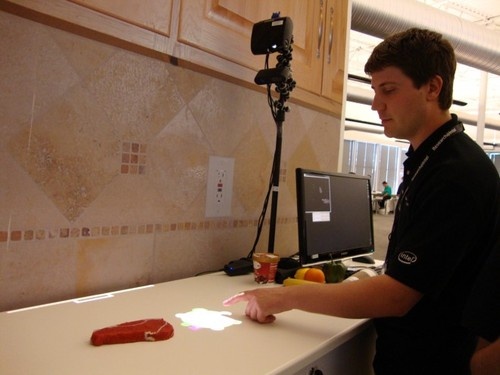下一代觸控面板將適用各種材質、各種場所與各種形狀

A research project from Intel can turn any surface into a touchscreen. Instead of propping up a tablet or putting a touchscreen computer in your kitchen, picture yourself tapping on the counter top to pull menus, look up recipes and add items to a shopping list.
"There's nothing absolutely special about the surface, and it doesn't matter if your hands are dirty," says Beverly Harrison, a senior research scientist at Intel. "Our algorithm and a camera set-up can create virtual islands everywhere"
Intel demoed the project during the company's annual research-day fest Wednesday to show touchscreens can go beyond computing and become a part of everyday life.
The project uses real-time 3-D object recognition to build a model of almost anything that's placed on the counter and offer a a virtual, touchscreen-based menu. For instance, when you put a slab of meat on the counter or a green pepper, they are identified, and a virtual menu that includes recipes for both are shown.
"The computer in real time builds a model of the color, shape, texture of the objects and runs it against a database to identify it," says Harrison. "And it requires nothing special to be attached on the steak or the pepper."
Smartphones have turned touch into a popular user interface. Many consumers are happy to give the BlackBerry thumb a pass and instead swipe and flick their finger to scroll. New tablets are also likely to make users want to move beyond a physical keyboard and mouse.
But so far, touchscreens have been limited to carefully calibrated pieces of glass encased in the shell of a phone or computer.
Intel researchers say that won't be the case in the future. An ordinary coffee table in the living room could morph into a touchscreen when you put a finger on it, and show a menu of music, video to choose from. Or a vanity table in the bathroom could recognize a bottle of pills placed on it and let you manage your medications from there.
Some companies are trying to expand the use of touchscreens. For instance, Displax, based in Portugal, can turn any surface - flat or curved - into a touch-sensitive display by sticking a thinner-than-paper polymer film on that surface to make it interactive.
Intel research labs try to do away with the extra layer. Instead, researchers there have created a rig with two cameras, one to capture the image of the objects and the other to capture depth. The depth cameras help recognize the objects and the difference between the hand touching the table or hovering over it. A pico-projector helps beam the virtual menus. The cameras and the pico-projector can be combined into devices just a little bigger than your cellphone, says Harrison. Sprinkle a few of these in different rooms and point them on tables, and the system is ready to go.
At that point, the software program that Harrison and her team have written kicks in. The program, which can run on any computer anywhere in the house, helps identify objects accurately and create the virtual menus. Just make a wide sweeping gesture to push the menu off the counter and it disappears. There's even a virtual drawer that users can pull up to store images and notes.
Harrison says all this will work on almost any surface, including glass, granite and wood.
"The key here is the idea requires no special instrumentation," she says.
Still it may be too early to make plans to remodel the kitchen to include this new system. The idea is still in the research phase, says Harrison, and it may be years before it makes it to the real world.
Photo: A counter top acts as a touchscreen display.
Priya Ganapati/Wired.com